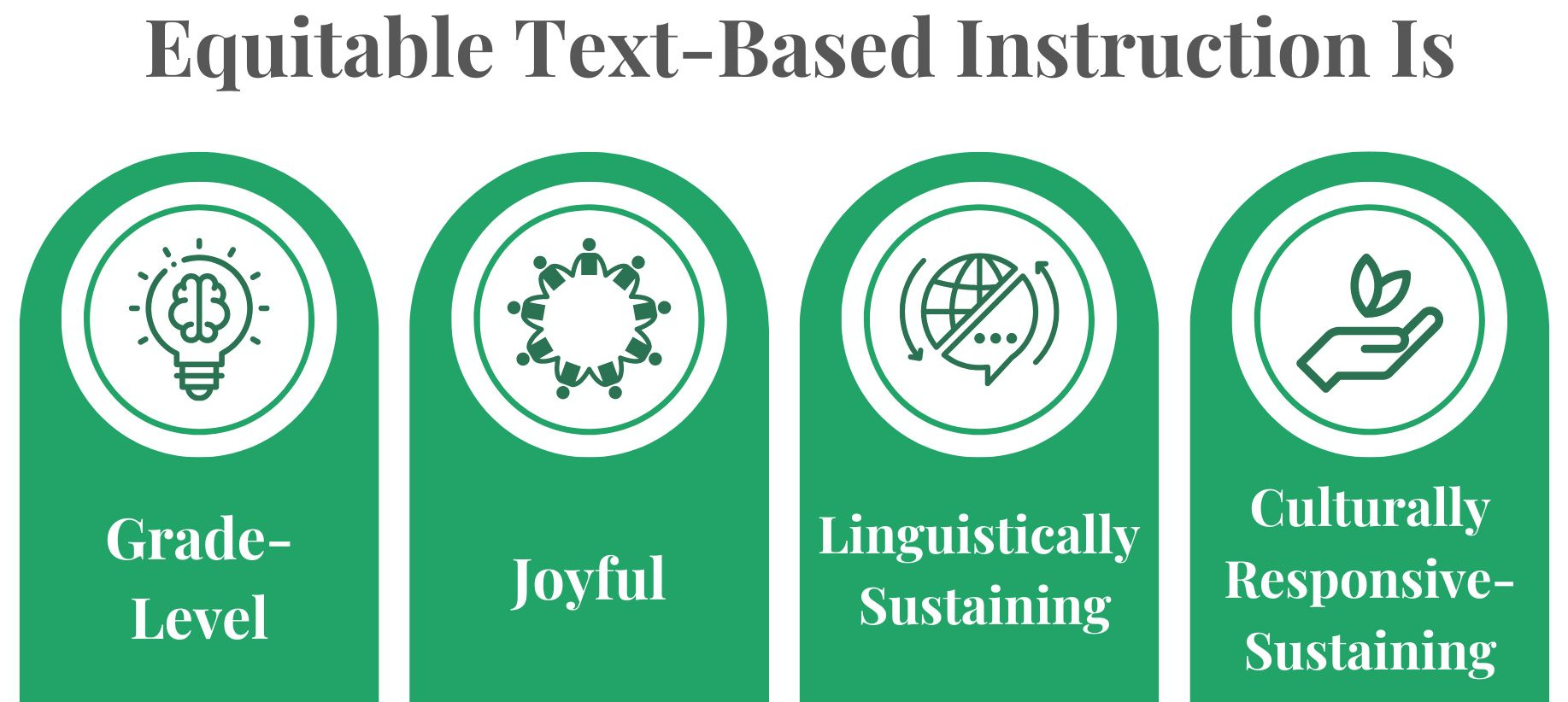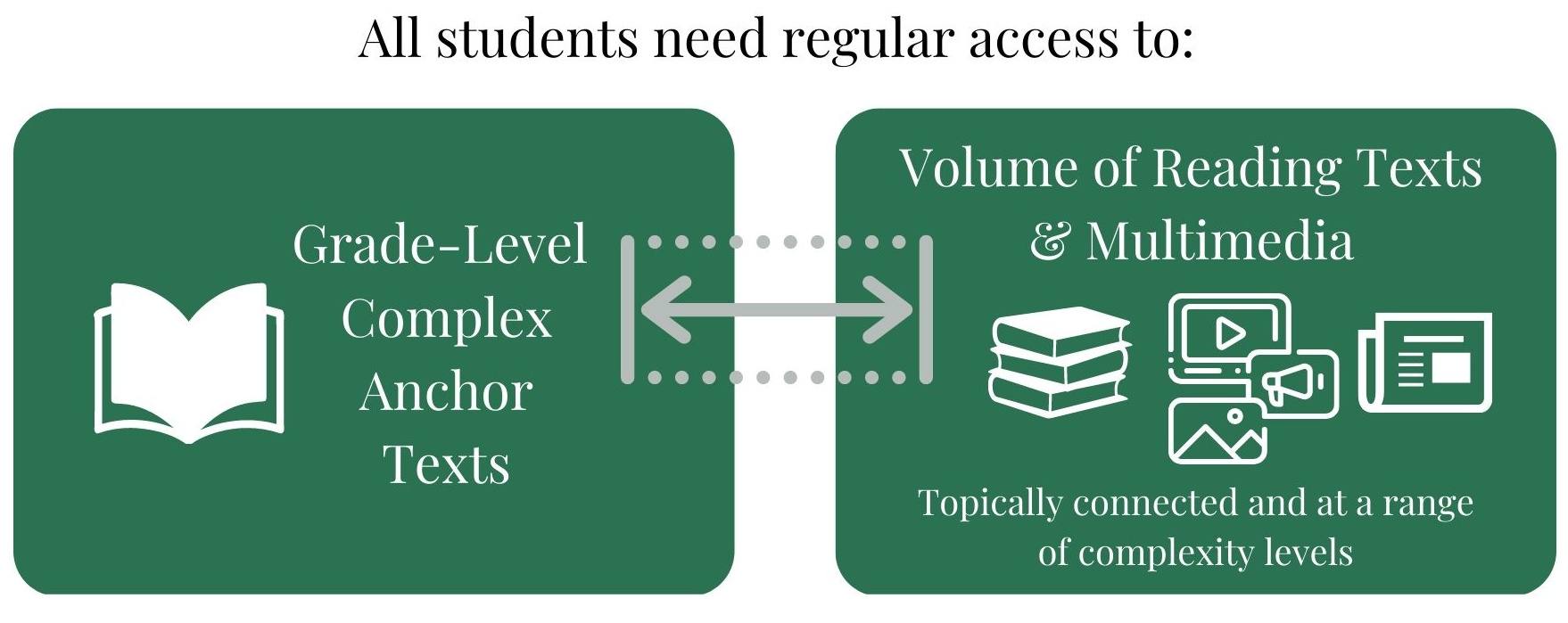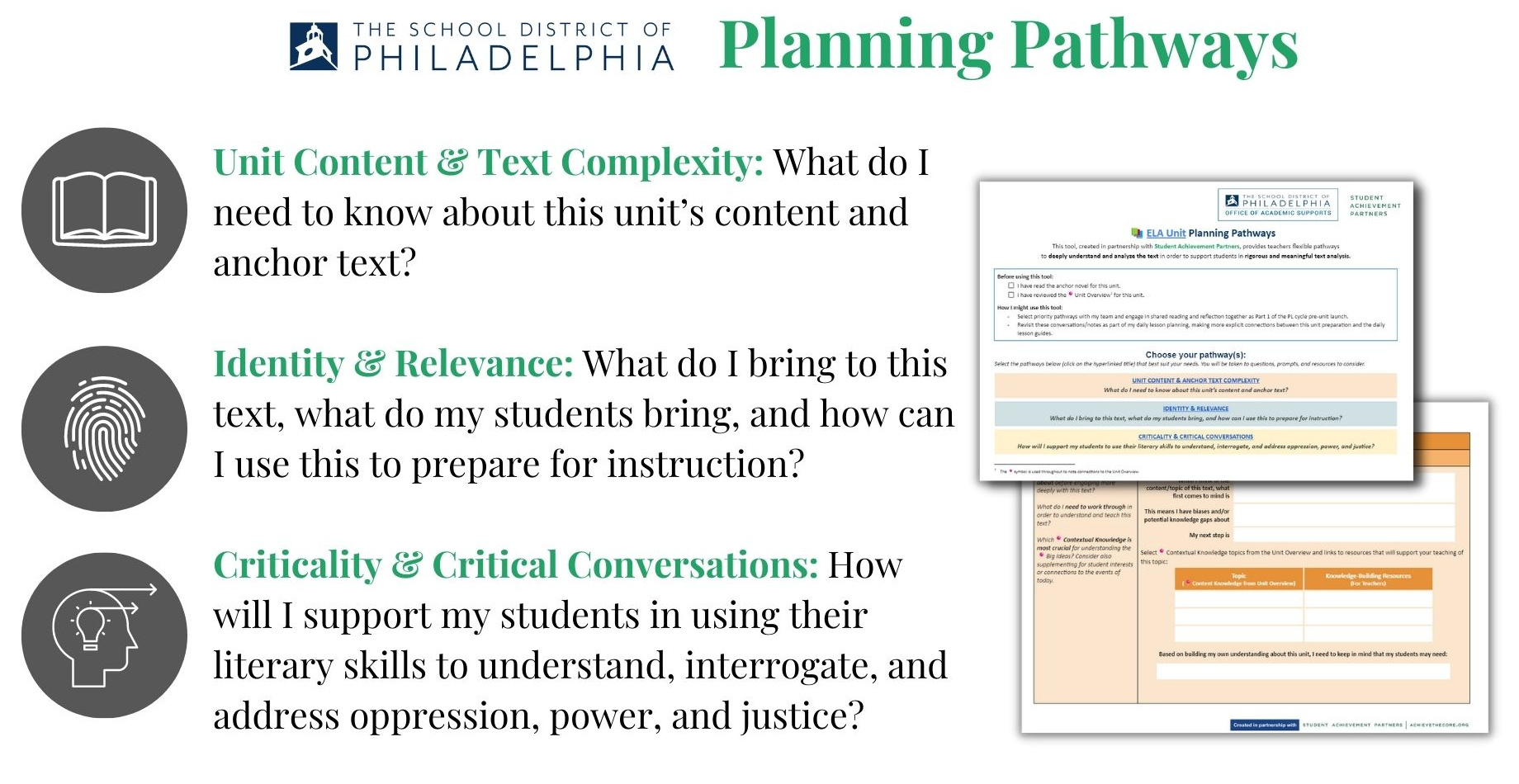Supporting Equitable Literacy Instruction through Text Selection, Analysis, and Use
Each and every student deserves equitable access and opportunity to develop their academic, linguistic, and cultural identities through grade-level, joyful, linguistically sustaining, and culturally responsive-sustaining learning experiences with texts. Students also deserve to be supported by educators who consistently uphold the efficacy for student assets in the literacy classroom.
In this resource hub you will find tools, models, and professional learning to support equitable literacy instruction, including: text analysis tools, sample lesson plans, and educator reflections about engaging in this work.
Research-Based Text Selection
How do we ensure that our text selection and text-based work is Grade-Level, Joyful, Linguistically Sustaining, and Culturally Responsive-Sustaining?A wide volume of research addresses text use in the classroom. These resources focus on what’s possible when we bring together concepts from education research and practitioner knowledge to create a coherent understanding of what equitable literacy instruction can be when we center student interests and student experiences.

Grade-Level: ensuring college- and career-ready Shifts- and Standards-aligned content and practices as well as creating the conditions for students from diverse racial, ethnic, and linguistic backgrounds to be able to engage with grade-level texts and instruction in the first place.
Joyful: developing a positive intellectual and emotional environment for learning by way of designing instruction to be engaging, empowering, and meaningful.
Linguistically Sustaining: seeing diverse linguistic backgrounds as assets that can be leveraged to engage students during instruction and foster deep content learning.
Culturally Responsive-Sustaining: leveraging the diverse backgrounds of students as assets in the classroom that can and should be sustained through intentional instructional design.
 What are texts to support equitable literacy instruction?
What are texts to support equitable literacy instruction?
Learn more about grade-level, joyful, linguistically sustaining, and culturally responsive-sustaining text-based work in this two-page resource.
Resources to build knowledge around text use in the classroom:
- Reading as Liberation—An Examination of the Research Base REPORT
- How We Read: A Graphic Guide to Literacy GRAPHIC GUIDE
- Planning and Reflecting with Culturally Relevant Pedagogy RESOURCE HUB
The Text Analysis Toolkit: Resources for Supporting Instruction

Know Yourself, Know Your Students
![]() Know Yourself, Know Your Students
Know Yourself, Know Your Students
A stand-alone reflection resource meant to support educators in thinking about their own identities and those of their students. Use at strategic points over time, for example, the beginning of the school year and after each semester, to continually reflect.
PDF | Word
Text Analysis & Reflection Tools
![]() Initial Considerations for Complexity & Cultural Relevance
Initial Considerations for Complexity & Cultural Relevance
A resource to use after a first read of a text to determine whether it’s usable for the classroom and to begin thinking about complexity and relevance. This includes determining whether a text should not be used, or whether the teacher will need to be thinking carefully about attending to cautions in the text when using with students.
PDF | Word
![]() Expanded Qualitative Analysis
Expanded Qualitative Analysis
A tool to analyze features of text more deeply in order to prepare for instruction. The rubric portion of the tool comes from the qualitative complexity rubrics that were published alongside the college- and career-ready standards, and the wording has not been changed. The prompts around challenges, opportunities, and questions to ask yourself are all new for this resource. There is one version for literary texts and another for informational texts.
+ Literary PDF | Word
+ Informational PDF | Word
![]() Mini Text Analysis Toolkit
Mini Text Analysis Toolkit
A condensed version of the Text Analysis Toolkit intended for more regular use. Includes considerations for identity, the features of the text that are most complex, and opportunities and cautions for equitable instruction.
PDF | Word | GoogleDoc
Toolkit Impact from Educators: Hear three educators discuss the Toolkit’s impact on their practice and the students they serve.
Sample Text Analyses
See completed text analyses for the texts below in the Sample Text Analysis for Equitable Instruction Bank. These analyses were done by educators using the Text Analysis Toolkit and include personal reflections about their own identities, students’ identities, and communities. Think about how you might use these resources to learn more about the Toolkit and text analysis; consider implications of using these texts in your own context; or review your own texts using these as inspiration.

Texts in the Sample Text Analyses for Equitable Instruction Bank were selected for a variety of reasons, including that they were books already part of a teacher’s library and that they provided opportunities for students to learn about a historically marginalized group and/or connect the topic to their own identities.
Is This a “Grade-Level” Text?
Research tells us that students should spend lots of time actively reading (or listening to in the early grades) complex texts. Despite this, many students are still denied rich learning experiences with grade-level texts due to the widespread use of leveling and tracking systems. Often, these practices fail to take into account how each student’s funds of knowledge impact their reading.
This does not mean that every text students encounter must be at grade-level complexity. Instead, students also need a volume of reading with texts at a range of complexity levels. We can maximize knowledge and vocabulary growth by engaging students with text sets, groups of resources connected by topic, to support these “miles on the page.”

 What is a grade-level text?
What is a grade-level text?
Learn more about grade-level complexity in this 2-page resource.
Instructional Planning
Lesson Guides for Equitable Instruction

Lesson Guide Template for Text-Based Instruction
K-5 Template
6-12 Template (with research project option)
Planning for Equitable Literacy Instruction
- Placing Text at the Center of the Standards-Aligned ELA Classroom GUIDANCE
- #DisruptTexts Guides LESSON EXAMPLES
- Planning and Reflecting with Culturally Relevant Pedagogy WEBSITE
Text Sets

 Designing Text Sets to Support Culturally Relevant Pedagogy
Designing Text Sets to Support Culturally Relevant Pedagogy
A four-page guide to creating your own text sets to create culturally relevant pedagogy
 Sample Text Sets to Support Culturally Relevant Pedagogy
Sample Text Sets to Support Culturally Relevant Pedagogy
Use or adapt these sample text sets for grades K-8, or use them as inspiration to design your own.
Educator Voices
Partner Snapshot: The School District of Philadelphia
Student Achievement Partners worked with the School District of Philadelphia to create a district-specific unit preparation tool to support their newly developed Curriculum Equity Initiative and anchor text resources. These resources were developed using the Text Analysis Toolkit as a starting point for customization, and the resulting unit planning tools focus on three flexible pathways for intellectual preparation in service of text-based, inclusive literacy.
See the resulting unit preparation and text analysis tools, as well as text-specific examples of this work in action, for Grades 8 and 12 here.
Educator Reflections
Toolkit Advice: Hear three educators discuss practical strategies for engaging in the work of using complex texts with inclusive representation in their classrooms.
Reflections on Equitable Text Selection & Instruction
- Text Complexity is well…complex! BLOG POST
- Diverse Texts: Are We “Leveraging” Them or Squandering Them? BLOG POST
- The Impact of Positive Representation in the Classroom BLOG POST
Additional Resources & Professional Learning
Learn More About Equitable Text Selection & Use
- Resource Roundup RESOURCE LIST
- Culturally Relevant Reflection Tool TOOL
- Disrupting the Canon FREE ONLINE COURSE

